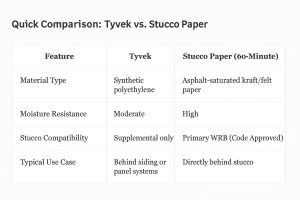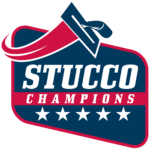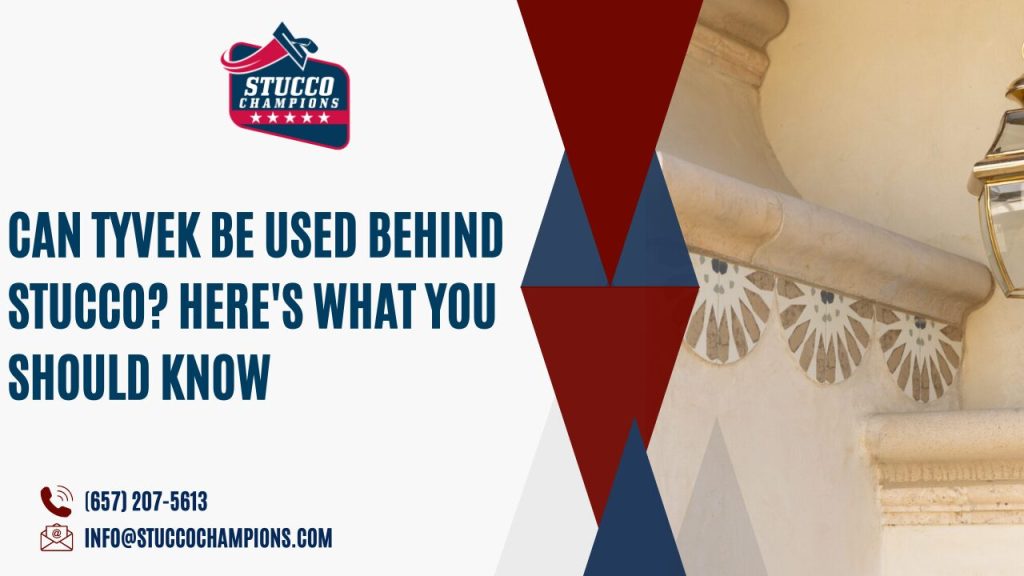Can Tyvek Be Used Behind Stucco? Here’s What You Should Know
When it comes to stucco installation, one of the most common questions homeowners ask is:
“Can Tyvek be used as a weather-resistant barrier (WRB) behind stucco?”
The short answer: Yes—but only as a secondary layer.
While Tyvek is widely used in other exterior wall systems like siding or fiber cement, stucco requires a very specific moisture management setup to prevent long-term water damage. Let’s break down how Tyvek fits into the picture—and why your project needs more than just synthetic house wrap to be code-compliant.
Tyvek vs Stucco Paper – What’s the Difference?
Tyvek is a synthetic material made by DuPont, designed to serve as an air and moisture barrier for building envelopes. It’s highly breathable, allowing moisture vapor to escape while protecting against water and air infiltration.
In siding applications, it’s great. But in stucco systems, it simply doesn’t hold up as a primary WRB due to the unique moisture loads stucco creates during curing.
Stucco Requires Higher Moisture Resistance
Unlike other cladding materials, stucco is applied wet and takes time to cure. During that process, moisture can become trapped between the layers, putting your home at risk for:
-
Mold growth
-
Rotting sheathing
-
Surface cracking
-
Delamination or bubbling
That’s why industry standards like ASTM C926 and ASTM C1063 require higher-performance WRBs, such as:
-
Two layers of Grade D building paper, or
-
A single layer of 60-minute stucco paper, specifically engineered for cementitious cladding systems.
These WRBs are water-resistant and vapor-permeable, allowing moisture to escape without letting water in.
Can Tyvek Be Used in Stucco Applications?
Yes, but only as a supplement, not a replacement. In some cases, a contractor might install Tyvek beneath the two-layer stucco paper for extra moisture protection, especially in climates with heavy rainfall.
However, Tyvek alone is not approved as the sole WRB for stucco installations under most building codes. Installing it without the proper paper backing can lead to non-compliance and major water damage issues later.
The Risks of Using the Wrong WRB
Many homeowners mistakenly think that any house wrap is enough. But using the wrong material—or layering it incorrectly—can lead to:
-
Stucco separation or cracking
-
Trapped water that can’t evaporate
-
Structural damage behind the finish
-
Costly repairs and mold remediation
Always ensure your contractor follows local codes and uses WRBs specifically designed for stucco.
Our Approach at Stucco Champions
At Stucco Champions, we never cut corners with your home’s protection. We use multi-layer WRB systems that meet and exceed local code requirements, whether you’re re-stuccoing or doing new construction.
Our crews are trained to install the right moisture barrier combinations for long-lasting protection—giving you peace of mind and a finish that holds up for decades.
Quick Comparison: Tyvek vs. Stucco Paper
| Feature | Tyvek | Stucco Paper (60-Minute) |
|---|---|---|
| Material Type | Synthetic polyethylene | Asphalt-saturated kraft/felt paper |
| Moisture Resistance | Moderate | High |
| Stucco Compatibility | Supplemental only | Primary WRB (Code Approved) |
| Typical Use Case | Behind siding or panel systems | Directly behind stucco |

This simple breakdown highlights key differences between Tyvek and stucco paper for your next stucco project. You can save this photo for reference.
FAQ: Tyvek and Stucco
Q: Can I use Tyvek under stucco in California?
A: You can, but only as a supplemental barrier. California building code still requires approved stucco WRBs like 60-minute paper or Grade D layers.
Q: Is it bad to install stucco over Tyvek only?
A: Yes. Doing so violates most codes and may lead to moisture problems, mold, and delamination.
Q: What is the best WRB for stucco?
A: We recommend two layers of Grade D building paper or 60-minute stucco paper for optimal moisture control and code compliance.
Q: How do I know if my current stucco job has proper WRB?
A: If you’re unsure, call a licensed contractor like Stucco Champions to perform a wall inspection and moisture evaluation.
Final Thoughts
Tyvek has its place—but not as your first line of defense under stucco. It can provide additional moisture control, but your project still needs a code-approved WRB to handle the unique demands of stucco.
Whether you’re redoing your exterior or building new, always ask about the moisture barrier. What’s behind the wall is just as important as what you see on the surface.
Ready to Simplify Your Stucco Work?
Contact Stucco Champions today for a free consultation!
Visit us at Stucco Champions for helpful resources and to learn more about our services.

